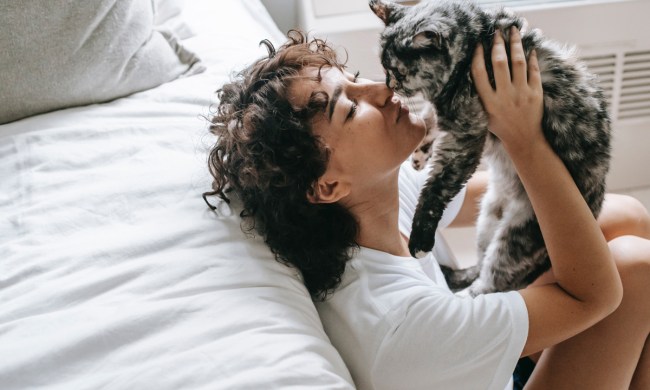In recent years, veterinarians have disproven everything we thought we knew about canine vision. Many folks are still finding out that dogs don’t see the world in black and white, but in shades of blue and yellow. This fascinating discovery has led many pet owners to ask, “What colors can cats see? Is it the same as what dogs can see?” There’s only one way to find out, so let’s get researching!
There are many avenues to explore when it comes to feline vision, so let’s break it down as simply — and colorfully — as possible. By the time you’re done reading, you’ll be able to imagine the world from your kitty’s point of view.
Can cats see color?

Many previously believed that cats see in black and white, but similar advancements in veterinary technology have led researchers to an exciting discovery: Cats can see colors! Their eyes don’t pick up on the entire visible light spectrum as humans do, but they can see at least two colors — potentially more. Of course, it’s hard to know for sure without a way to communicate with our feline friends, so this is based on veterinarians’ most educated guess.
What colors can cats see?

There is still some debate among cat veterinarians and feline researchers, but the most popular theory is that cats mainly see shades of blue and yellow — just like dogs. Some believe that cats can even detect shades of green, while others think that cats can only see blues. Of course, felines can see black, white, and every shade of gray in between.
With this type of color blindness, cats would not be able to see red, pink, purple, or even orange. Don’t feel too bad for them, however — this is the only reality they know. In many ways, their excellent eyesight makes up for the colors they can’t see, so cats aren’t missing out.
The way eyes perceive colors has to do with cells in the retina (the light-sensitive part of the eye) called rods and cones. Rods are sensitive to light levels and can assist with seeing in the dark, while cones are color sensitive. However, cats can only see shades of a few colors because they have 10% of the number of cones in the eye that humans do. The higher the number of cones in the eye, the more colors an animal can see.
Can cats see in the dark?

It comes as no surprise that cats can see very well in the dark. After all, felines are crepuscular creatures, meaning that they’re most active at dawn and dusk. They’re likely to hunt and play during this time, which wouldn’t be possible if they didn’t have excellent low-light vision. As we learned, this is due to a high concentration of rod cells in the retina, which is responsible for capturing light.
However, there are a few other reasons why cats see so well at nighttime. First, cats have vertical, elliptical-shaped pupils with two more muscles on either side of the eye. This allows them to dilate and constrict the pupil much more dramatically than humans can, letting their eyes take in a large amount of light in dim environments.
Second, cats have reflective cells beneath the retina called the tapetum. This reflects light back through the retina, allowing the cat to see better in low light. Fun fact: this is also what causes a cat’s eyes to reflect when photographed at night.
How does a cat’s eyesight compare to a human’s?

Humans who are red-green colorblind may have a glimpse at what our furry friends can see. Although it isn’t an exact comparison, colorblind people can experience muted tones and confusing or missing colors in the visible light spectrum. Purina guesses that, for cats, reds and pinks appear green or yellow, while purple appears blue.
As mentioned, cats can see much better in low light than humans can. But because of the higher number of rods in the retina, their eyes are also more sensitive to movement. It’s no wonder your cat can see things that you miss.
With their eyes on either side of their head instead of forward-set like human eyes, cats can have a wider field of vision. However, the cost is poorer depth perception. Cats are also more near-sighted than humans are, with objects not becoming clear until they’re about 20 feet away.
Needless to say, feline vision is quite different than a human’s perception of the world. This may be odd to wrap your head around, but remember — this is all normal to cats.




